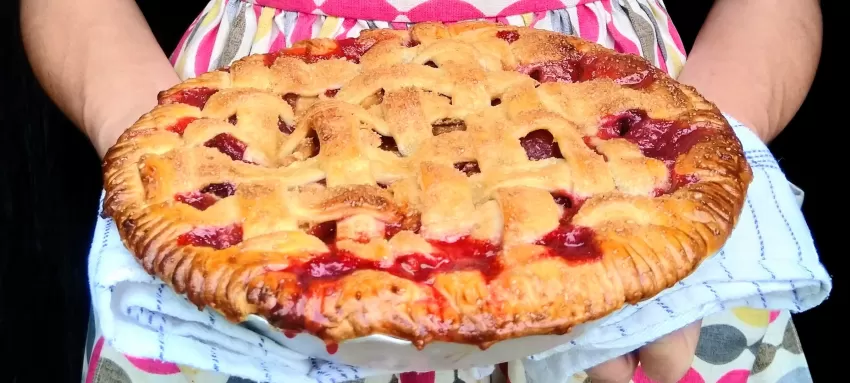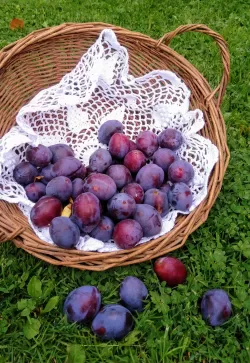Ella's wickedly English Plum Pie

Plum season is well and truly upon us. I know this because I can’t set foot in the garden without being physically attacked by plums, which like to hurtle themselves at me with great force! It isn’t what you’d necessarily expect from the humble-looking plum trees stood among the rubble and salvage of the Victorian house my husband I are slowly restoring ourselves.
I complain of course, but this kind of behaviour is perhaps to be expected of plums if you consider their reputation for general wickedness through history. As Nicholas Culpeper, the well regarded herbalist, wrote in 1653 [1];
All plums are under Venus, and are like women, some better and some worse. As there is a great diversity of kinds, so there is in the operation of Plums…The moist and waterish do sooner corrupt in the stomach, but the firm do nourish more, and offend less.
For centuries prior to this the humble plum and other such fruits were treated with even greater suspicion and were never eaten raw. In fact, during the English plague of 1569, the selling of fresh fruit was banned by law as they were thought to carry disease [2]. Despite this, plums and other such untrustworthy soft fruits were still popular cooked into meat dishes and sweet delicacies such as fruit pies.
Throughout the late medieval and Tudor periods, wealthy households would delight their guests with fruit dishes cooked with exotic spices, nuts and sugar, in part to cover the taste of the fruit, and in part as a show of wealth, power and good taste as expensively imported spices and sugars made their way onto the culinary scene [3]. Of course it helps that tart fruit mingles perfectly with sweet sugar and warming spices, such as cinnamon, nutmeg and ginger, to create a mouthful of perfection, so it’s hardly surprising that the habit of adding spices to fruit dishes has endured. What is an apple crumble without a dash of cinnamon, and where would the mince pie be without all those festive spices?
Thankfully these days fruit is much more highly regarded, celebrated even. Foraging and growing your own fresh fruit and veg is a popular pastime, and what better way to use up a glut of home-grown plums with a slice of delicately spiced plum pie with lashings of cream or custard while you think about how naughty these little fruits have been in the past.
Perfect for warming the spirits as those hazy late summer days roll into autumn.
![]()
How to make Plum Pie
This is my plum pie recipe. The filling borrows heavily from a Jamie Oliver recipe [4].
I hope you enjoy it:
Ingredients for Plum Pie
For the pastry
- 300g (2 cups) plain flour
- 150g (⅔ cup) cold butter, cubed
- 2-3 tbsp icing sugar (depending on preference)
- 3 medium free-range egg yolks
- Splash of cold water
For the egg wash
- 1 egg yolk
- Splash of milk
For the filling
- 1kg (around 5 cups) plums approx, de-stoned and halved (in my case, a standard ice-cream tub half filled with plums was about right)
- 50g (¼ cup) butter, cubed
- 3 - 4 tbsp brown sugar
- 2 tsp mixed spice (or you can use Pumpkin Spice mix)
- 1 tbsp cornflour
- 2 tbsp ground almonds
- Splash of almond extract (optional)
Method
- Pre-heat the oven to 180°c/350°f/Gas Mark 4.
- In a large bowl, combine butter and flour by rubbing together between your thumb and fingers, in a motion not unlike clicking your fingers. The butter should be fridge-cold. You are seeking to achieve a flaky, rough texture.
- Stir in the sugar, the egg yolks, and a splash of cold water as necessary. Combine and turn out onto a lightly floured surface.
- Knead the mixture into a dough for approximately 30 seconds, but don’t overwork it.
- Place in a covered bowl and refrigerate for 30 minutes. Have a cup of tea, and then get started on the filling.
- Mix the plums and all the other filling ingredients in a bowl and set aside.
- When the pastry is sufficiently chilled, divide it into two parts—approximately a part of one third and two thirds in the other. Roll out the larger chunk on a lightly floured surface and place into a deep pie dish.
- Heap in the filling, and then roll out the second chunk of pastry and cut into strips around 2cm wide.
- Use the egg wash to dampen the edges of the pastry in the dish, place the strips over the filling in a lattice. Trim and crimp the edges. Chill for a further 20-30 minutes to firm up again and give the top of the pie a good slather of egg wash and dredge with brown sugar before popping into the oven.
- Bake in the middle of the oven for approximately 40 minutes until the pastry is golden brown.
- Serve with custard, cream, or ice-cream.
Make sure to enjoy with a good cup of tea!

Reviving traditions...
Ella Florence is a mother, housewife and domestic history nerd. She’s passionate about cooking, entertaining and tea, and is currently restoring a crumbling house on the Somerset-Dorset border with her husband, all the while dreaming of the dinner parties she’ll throw when it’s finished. She also works as an architectural draftsman and florist.
You can follow their story @the_young_revivalists
Ella shared this beautiful picture of her Plum Pie in our Facebook group this week, and I just had to ask her to share the recipe with the rest of the world. Doesn’t it look delicious? Let us know if you make it.
Happy Homemaking!
Alena xxx
All content and images in this article are copyright of The Darling Academy and are not to be shared or reproduced without our express permission. [1] Culpepper, Nicholas: The Compleat Herbal (1653) [2] Selby, Anna: Food Through the Ages (2008) [3] Black, Maggie: Medieval Britain in A Taste of History (1993) [4] https://www.jamieoliver.com/recipes/fruit-recipes/plum-lattice-pie/ Affiliate links have been used in this post.


